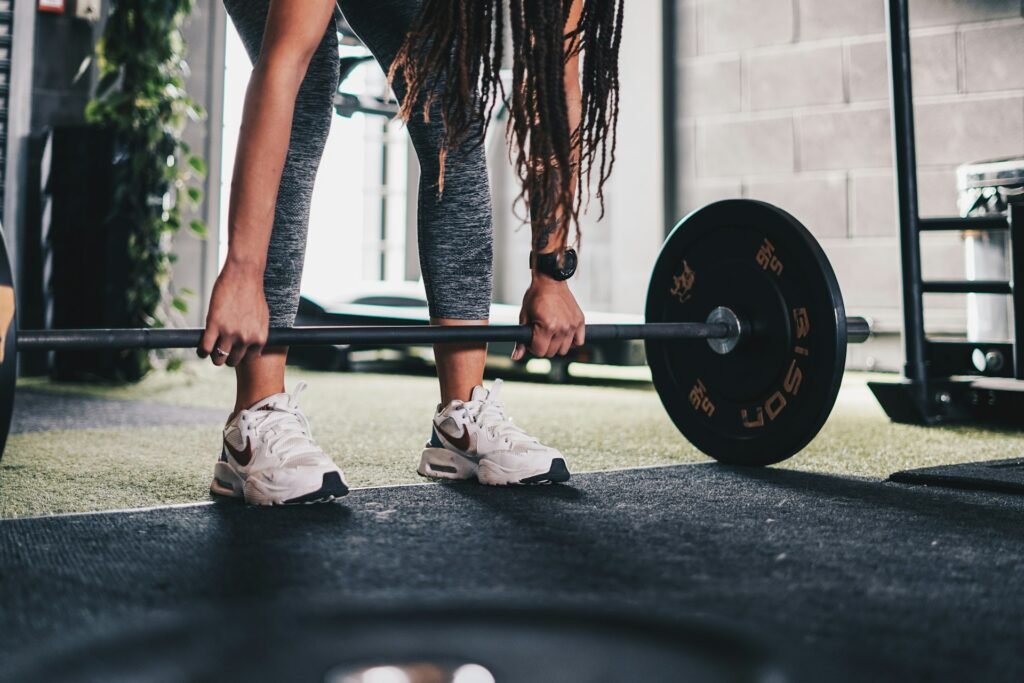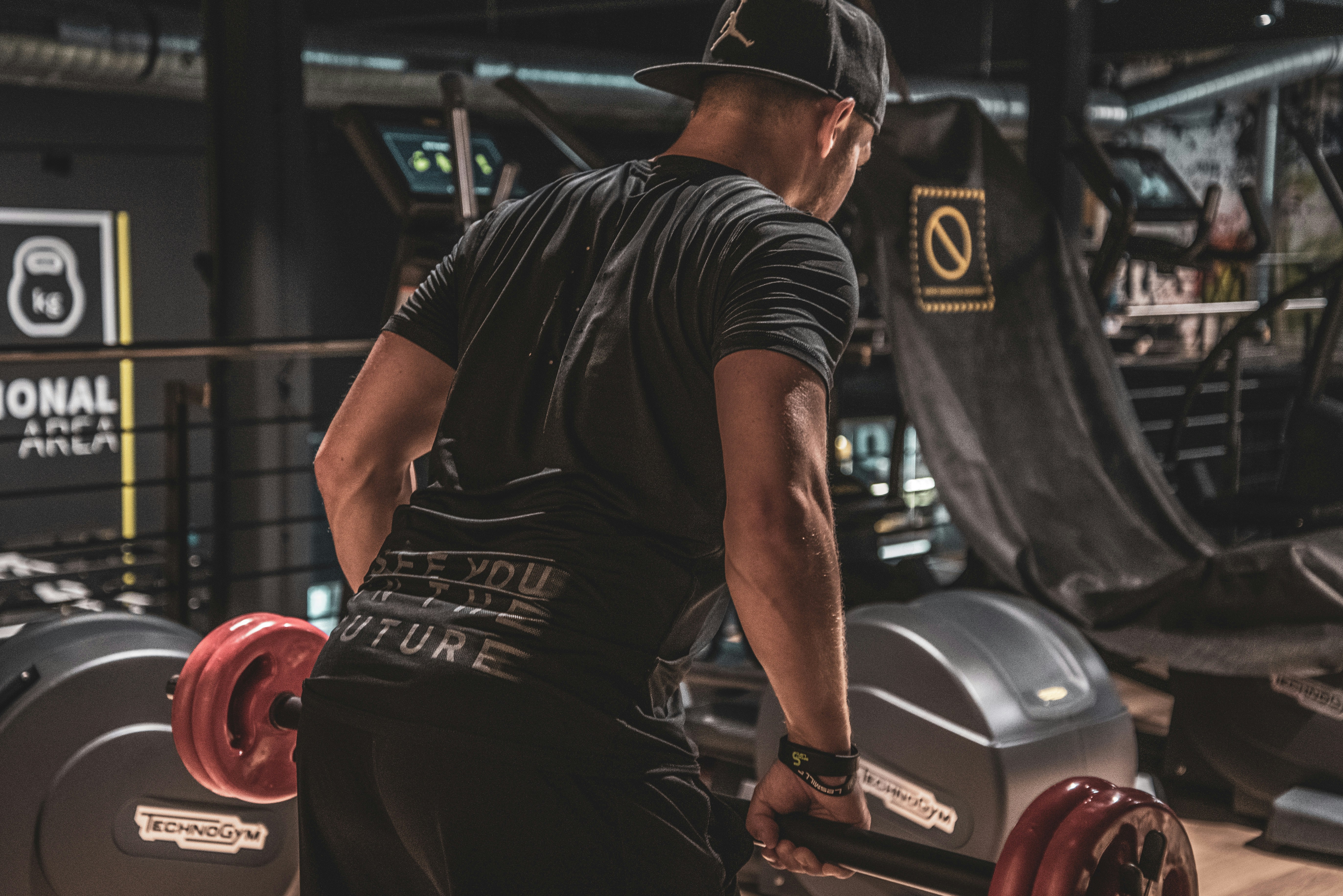
Photo by Ambitious Studio* | Rick Barrett on Unsplash
Choosing between an overhand and an underhand barbell row can be puzzling for many fitness enthusiasts. Both variations are highly effective for building back strength and muscle, but they each target different muscle groups. Understanding these differences can help you choose the right exercise for your fitness goals.
An overhand grip barbell row involves holding the barbell with your palms facing down. This grip primarily engages the upper back muscles, such as the traps and rhomboids. On the other hand, an underhand grip barbell row, where the palms face up, emphasizes the lower lats and biceps more (T Nation).
When performing these exercises, the direction your elbows move in plays a crucial role in determining the targeted muscles. For example, with an underhand grip, the elbows stay closer to the body, focusing on the lower lats. Conversely, an overhand grip causes the elbows to flare outwards, engaging the upper back more intensely.
Despite these differences, both variations are valuable additions to a workout routine. They collectively contribute to a balanced and well-developed back, helping to prevent muscle imbalances and enhance overall strength. For those interested in maximizing their cardio routine as well, check out our guide on steady state cardio examples.
By understanding the unique benefits of both the overhand and underhand barbell row, you can make informed decisions about which exercise aligns best with your fitness objectives.
Understanding Overhand Barbell Row
The overhand barbell row, also known as a pronated barbell row, is a staple in strength training routines. This exercise targets the upper back muscles, including the rhomboids, middle, and lower trapezius, and rear deltoids. When you use an overhand grip, your elbows naturally flare out, creating a wider range of motion that emphasizes these upper back muscles.
A study published in the Journal of Strength and Conditioning Research found that using an overhand grip while performing rows can increase the activation of the trapezius muscles by about 25% compared to an underhand grip [^1^]. This makes the overhand barbell row an effective exercise for those looking to build a robust upper back.
Proper form is crucial in maximizing the benefits of the overhand barbell row. Start by gripping the barbell with your hands slightly wider than shoulder-width apart. Bend your knees slightly and lean forward at the hips, keeping your back straight. Pull the barbell towards your lower chest or upper stomach, ensuring that your elbows stay flared out.
Despite its benefits, this grip can put strain on the wrist and shoulder joints if not done correctly. Beginners should start with lighter weights to perfect their form before increasing the load. Additionally, individuals with pre-existing shoulder issues might find this grip uncomfortable and may need to modify their approach or consult a fitness professional.
For more exercises focusing on specific muscle groups, you can check our guide on back exercises with barbell.
[^1^]: Sapstead, G., “Overhand vs Underhand Barbell Rows,” The Fitness Maverick, 2023.
Understanding Underhand Barbell Row
The underhand barbell row is a powerful exercise that targets the back muscles, particularly the latissimus dorsi, and also engages the biceps, forearms, and rear deltoids. Unlike the overhand grip, which places more emphasis on the upper back and trapezius muscles, the underhand grip allows for a greater range of motion and engages the lower portion of the lats more effectively.
This exercise is beneficial for those looking to develop a well-rounded back and improve their pulling strength. According to a study by the American Council on Exercise, the underhand grip can increase muscle activation in the biceps by up to 20% compared to the overhand grip source.
To perform the underhand barbell row correctly, start by grasping the barbell with a supinated grip (palms facing up) at shoulder-width distance. Bend your knees slightly, hinge at the hips, and keep your back straight. Pull the barbell towards your torso, squeezing your shoulder blades together at the top of the movement. Slowly lower the weight back down, maintaining control throughout the range of motion.
Just like any other exercise, proper form is crucial to prevent injury and maximize effectiveness. For more back exercises and to understand the comparative benefits of different rowing forms, check out our guide on back exercises with barbell.
Form and Technique for Overhand Barbell Row

Photo by Sven Mieke on Unsplash
Performing the overhand barbell row with proper form and technique is essential for maximizing muscle engagement while minimizing the risk of injury. Here’s a step-by-step guide:
- Grip: Start by grabbing a barbell with a slightly wider than shoulder-width overhand grip. This grip helps target the upper lats and mid-back effectively (source).
- Stance and Bend: Stand with your feet shoulder-width apart. Bend forward at the hips until your torso is parallel to the floor. Maintain a slight bend in your knees and an arched back to provide stability and protect your lower back.
- Starting Position: Let your shoulders protract naturally. Avoid excessive rounding of your back. This position places your muscles in an optimal stretch, which can help activate them more effectively during the exercise.
- Rowing Motion: Pull the barbell towards your abdomen. Keep your elbows close to your body throughout the movement. This technique focuses the effort on the back muscles rather than allowing the biceps to dominate.
- Peak Contraction: For beginners, pausing briefly at the top with the bar touching your midsection can help familiarize with the movement. This pause should be eliminated as you progress to avoid early muscle fatigue.
- Lowering the Bar: Lower the barbell in a controlled manner back to the starting position. Allow your shoulder blades to protract fully to stretch the involved muscles (source).
- Reps and Sets: Aim for sets of 10-15 reps. Performing fewer reps with heavier weights can lead to form breakdown and potential injury, while too many reps with lighter weights may not recruit the target muscles adequately.
By following these steps, you can ensure that you are performing the overhand barbell row safely and effectively. Consistent practice with proper form will help you build strength and definition in your upper back. For advice on other back exercises, check out at-home dumbbell back workout.
Form and Technique for Underhand Barbell Row

Photo by Jonathan Borba on Unsplash
Proper form and technique are essential for maximizing the benefits and preventing injuries when performing the underhand barbell row.
- Grip: stand holding a barbell with an underhand grip, meaning your palms face up. Your feet should be shoulder-width apart. Bend your knees slightly and lean forward at your hips, ensuring that your back remains straight. Your torso should be almost parallel to the floor, a stance that engages your core and stabilizes your body.
- Starting Position: Keep your elbows close to your body while pulling the barbell toward your lower chest.
- Rowing Motion: Focus on squeezing your back muscles as you lift the bar. It’s important to move in a controlled manner to maximize muscle engagement and avoid cheating with momentum.
- Lowering the Bar: Lower the barbell back to the starting position in a slow and controlled manner. This controlled descent is just as important as the lift itself for muscle engagement and injury prevention.
Statistics show that the underhand barbell row is highly effective for working multiple muscle groups, including the arms, back, and shoulders. This compound movement efficiently splits the load between these muscles, making it a popular choice among both beginners and advanced lifters (Men’s Health, 2014).
For those new to this exercise, starting with a lighter weight until mastering the form is advisable. Incorrect form can put unnecessary strain on the lower back and increase injury risk.
You might also be interested in our guide on Back Exercises with Barbell for more tips and techniques.
Common Mistakes and How to Avoid Them
When performing the overhand or underhand barbell row, there are several common mistakes that can hinder your progress and potentially lead to injury. Here are some pitfalls to watch out for:
- Improper Form: One of the most frequent mistakes is having poor form during the exercise. This includes rounding your back or not engaging your core, which can lead to lower back injuries. To maintain proper form, always keep your back straight and core tight.
- Excessive Weight: Using too much weight can sacrifice form and lead to injuries. It’s crucial to select a weight that allows you to complete the desired number of reps with proper technique. A study by the National Strength and Conditioning Association found that 62% of weightlifting injuries occur when individuals lift too much weight source.
- Incorrect Grip: Whether you’re doing an overhand or underhand row, improper grip can affect your performance and the muscles you target. Ensure you are gripping the bar firmly and evenly to optimize your workout.
- Swinging the Weights: Using momentum to lift the weights instead of muscle power is another common issue. This can result in ineffective workouts and increased risk of strain. Instead, use a controlled motion to lift and lower the weights.
- Neglecting Warm-Up: Skipping a proper warm-up can set you up for muscle strains and other injuries. Always take the time to do a full-body warm-up to get the blood flowing to your muscles.
To maximize your performance and minimize risks, consider reading our Barbell Shoulder Workout guide for detailed warm-up routines and additional tips on muscle engagement.
Avoid these mistakes to ensure a safer and more effective barbell row workout. For more information on proper weightlifting techniques, visit our article on Back Exercises with Barbell.
Reference:
- National Strength and Conditioning Association. (n.d.). Weightlifting injury rates across different muscle groups. Retrieved from https://www.ncbi.nlm.nih.gov/pmc/articles/PMC5665167/.
Conclusion: Choosing the Right Row for Your Goals
Selecting between overhand and underhand barbell rows depends on your personal fitness goals and anatomical comfort. The overhand barbell row primarily targets the upper back muscles, including the trapezius and rhomboids, and may be more suitable for those looking to improve postural support and upper back strength. This grip also tends to be easier on the wrists for many lifters.
On the other hand, the underhand barbell row shifts emphasis to the lower lats and biceps, and can be a better option for those aiming to build a thicker back and develop arm strength simultaneously. However, this grip might place more stress on the wrists.
Research from the National Strength and Conditioning Association shows that incorporating different rowing variations can improve muscle imbalances and contribute to a more rounded development (NSCA, 2022).
Considering your long-term objectives, such as focusing on aesthetics, sports performance, or overall strength, will help determine the best approach for you. Whether you aim to enhance your upper back silhouette or strengthen your lower lats, choosing the row that aligns with your goals is crucial.
For more targeted exercises to complement your routine, you might find our articles on back exercises with a barbell beneficial.